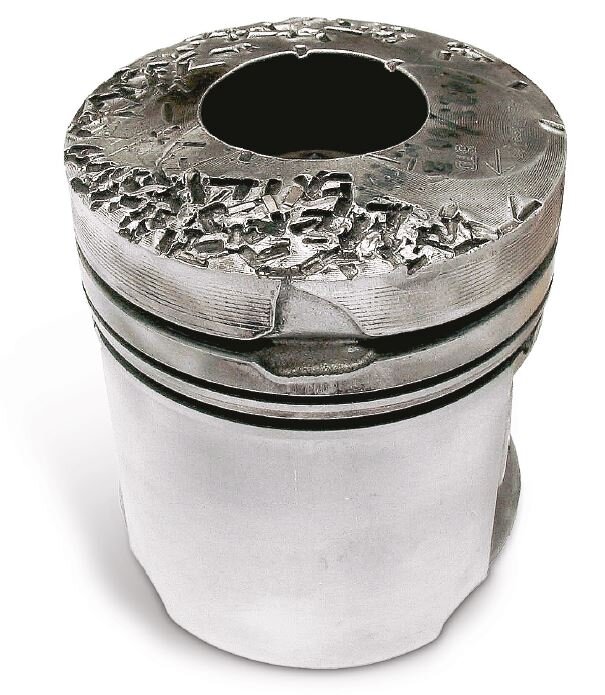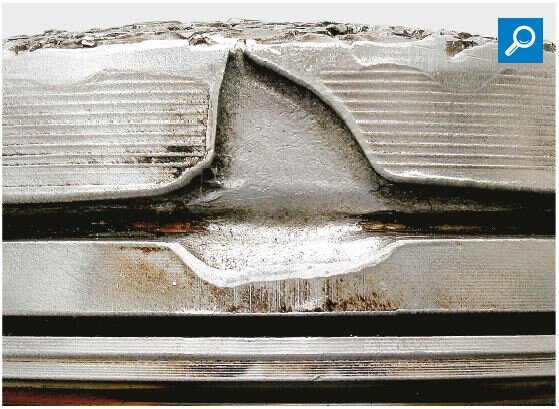Material washout in the piston ring zone (piston ring fracture)
DESCRIPTION OF THE DAMAGE
- Severe material washout reaching as far as the piston crown in the ring zone in the area of the first ring groove.
- Severe axial wear on the first ring groove.
- Severe mechanical damage on the piston crown.
- Running pattern of the piston skirt has a matt, buffed appearance.


DAMAGE ASSESSMENT
The damage is caused by the ingress of contamination into the combustion chamber. This is indicated by the severe axial wear on the grooves and on the first ring groove in particular. The contamination was then also deposited in the ring groove, where they caused abrasive wear on the piston ring and the ring groove. The axial clearance of the piston rings increased steadily as a result. In terms of its cross section, the piston ring was severely weakened, and it could no longer withstand the pressures of the combustion process and broke. Consequently, the broken-off part of the piston ring could move around practically unhindered in the rapidly enlarging groove. The washout shown in the picture was caused as a result of continuous “hammering” of this broken-off part. Once the washout reached the piston crown, the fragments of the piston ring entered the combustion chamber where they caused more damage.
POSSIBLE CAUSES FOR THE DAMAGE
- Severe axial wear on the ring groove and the piston rings caused by ingress of foreign bodies into the combustion chamber.
- If there is severe radial wear to the piston rings without any axial wear, then a likely cause is mixed friction wear as a result of fuel flooding.
Refer to the chapter entitled “Wear caused by fuel flooding”.
- If there is no wear on the ring grooves or piston rings and the engine has only been run a short time after reconditioning, the problem is often caused by incorrect installation of the piston. It is possible for the piston rings to be broken when the piston is inserted if the piston rings have not been pressed far enough into the ring groove. This happens if an incorrect or damaged insertion tool is used or if the piston ring scuff band is not fitted and tightened correctly around the piston.
- Ring flutter caused by excessive axial clearance of the piston rings. This is caused if only a new set of piston rings is installed during engine repairs, even though the ring grooves in the piston are already worn. The excessive clearance causes the piston rings to flutter and possibly break. Another reason may be the use of an incorrect set of piston rings: the height of the rings may be too small and the axial clearance in the groove therefore too great.
- A piston that is unsuitable for the intended purpose. Due to the greater loads and longer service life involved, pistons for diesel engines are equipped with a ring carrier made of cast iron alloyed with nickel. Pistons without a ring carrier are sometimes used on diesel engines for cost reasons, but only if the engines‘ service life is expected to be shorter. This could be the case on e.g. agricultural machinery. If this type of piston without a ring carrier is used in engines that are intended to cover high mileage, there is a chance that the wear resistance of the ring grooves may not be sufficient.